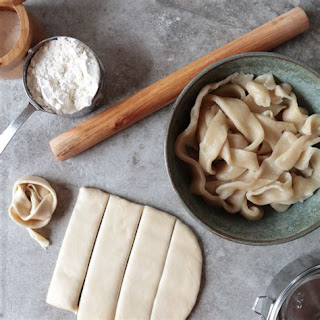These noodles are characterised as being very rich and bright yellow. To add that homemade touch, cut the noodles by hand with a sharp knife and make about half an inch wide.
3 cup fine ground Durham (durum) flour
1 teaspoon salt
6 egg yolks from organic brown eggs
6 egg yolks from organic brown eggs
1 cup of semolina
2 tablespoons of water
Make a well in the flour and add the rest of the ingredients by combining with a fork. Finish kneading by hand, by pushing the dough away with the heal of your hand. Gather into a ball and knead well. Cover with plastic wrap and left rest 15 minutes. Using a pasta machine, pinch off a fist size clump and run in repeatedly through the pasta machine on the thickest setting until completely ductile and silky. Now roll to desired thickness usually as thin as possible. Switch attachment to a fettuccine cutter and slit noodles lengthwise. Repeat until all noodles are done. Dry noodles on handle of a broom or drying racks.
Allow to dry for about 2 hours or more before cooking.
Notes:
Wheat and Durum wheat are both grains but they differ in hardness, intended use, and protein content. All purpose (AP) flour is usually 10-12% protein while durum 12-15%.
Pasta Blend (King Arthur)
Durum wheat (Triticum durum) is a hard, high-protein variety of wheat known for its amber color, nutty flavour, and exceptional gluten-forming potential due to its elevated protein content; durum’s hardness comes from its dense endosperm, the starchy core of the grain.
Semolina, on the other hand, is a milled product derived exclusively from durum wheat. It’s created by grinding the endosperm into a coarse, granular flour—think of it as midway between fine flour and cracked wheat, with particles resembling fine sand. This coarseness is key: semolina isn’t finely powdered like all-purpose flour, semolina is generally harder to roll than durum flour. This stems from semolina’s coarser, grittier texture—it’s essentially a rough grind of durum wheat endosperm—compared to the finer, smoother consistency of durum flour. The coarseness of semolina slows hydration, often requiring the dough to rest; its larger granules give it a gritty texture that absorbs water slowly, preventing dough from becoming gummy and allowing for the firm, al dente “bite” in pasta.
Semolina, being coarser and denser, has a higher resistance to over-hydration and is prized for extruded pastas, or even as a dusting agent to prevent sticking.
Semolina is generally harder to roll than durum flour when making dough. This stems from semolina’s coarser, grittier texture. The coarseness of semolina slows hydration, often requiring the dough to rest.

No comments:
Post a Comment